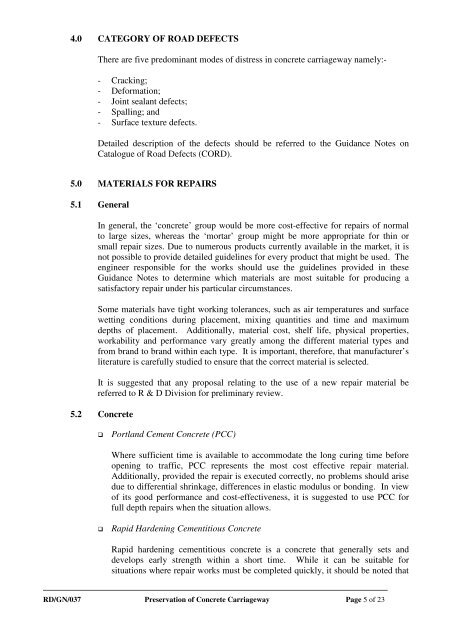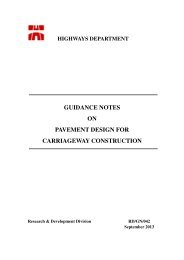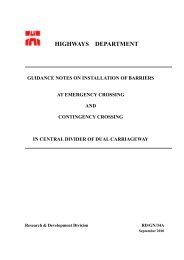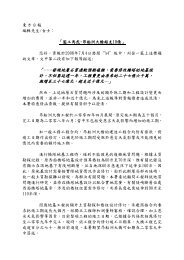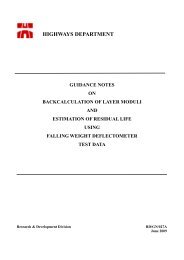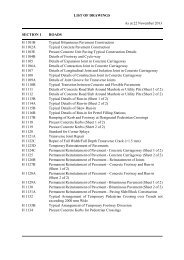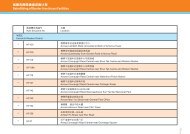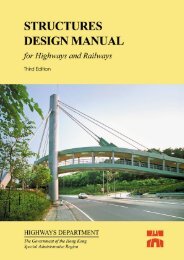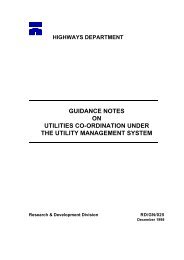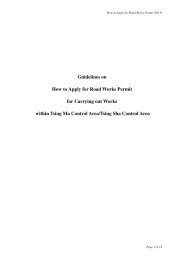Preservation of Concrete Carriageway
Preservation of Concrete Carriageway
Preservation of Concrete Carriageway
You also want an ePaper? Increase the reach of your titles
YUMPU automatically turns print PDFs into web optimized ePapers that Google loves.
4.0 CATEGORY OF ROAD DEFECTS<br />
There are five predominant modes <strong>of</strong> distress in concrete carriageway namely:<br />
- Cracking;<br />
- Deformation;<br />
- Joint sealant defects;<br />
- Spalling; and<br />
- Surface texture defects.<br />
Detailed description <strong>of</strong> the defects should be referred to the Guidance Notes on<br />
Catalogue <strong>of</strong> Road Defects (CORD).<br />
5.0 MATERIALS FOR REPAIRS<br />
5.1 General<br />
In general, the ‘concrete’ group would be more cost-effective for repairs <strong>of</strong> normal<br />
to large sizes, whereas the ‘mortar’ group might be more appropriate for thin or<br />
small repair sizes. Due to numerous products currently available in the market, it is<br />
not possible to provide detailed guidelines for every product that might be used. The<br />
engineer responsible for the works should use the guidelines provided in these<br />
Guidance Notes to determine which materials are most suitable for producing a<br />
satisfactory repair under his particular circumstances.<br />
Some materials have tight working tolerances, such as air temperatures and surface<br />
wetting conditions during placement, mixing quantities and time and maximum<br />
depths <strong>of</strong> placement. Additionally, material cost, shelf life, physical properties,<br />
workability and performance vary greatly among the different material types and<br />
from brand to brand within each type. It is important, therefore, that manufacturer’s<br />
literature is carefully studied to ensure that the correct material is selected.<br />
It is suggested that any proposal relating to the use <strong>of</strong> a new repair material be<br />
referred to R & D Division for preliminary review.<br />
5.2 <strong>Concrete</strong><br />
o<br />
Portland Cement <strong>Concrete</strong> (PCC)<br />
Where sufficient time is available to accommodate the long curing time before<br />
opening to traffic, PCC represents the most cost effective repair material.<br />
Additionally, provided the repair is executed correctly, no problems should arise<br />
due to differential shrinkage, differences in elastic modulus or bonding. In view<br />
<strong>of</strong> its good performance and cost-effectiveness, it is suggested to use PCC for<br />
full depth repairs when the situation allows.<br />
o<br />
Rapid Hardening Cementitious <strong>Concrete</strong><br />
Rapid hardening cementitious concrete is a concrete that generally sets and<br />
develops early strength within a short time. While it can be suitable for<br />
situations where repair works must be completed quickly, it should be noted that<br />
RD/GN/037 <strong>Preservation</strong> <strong>of</strong> <strong>Concrete</strong> <strong>Carriageway</strong> Page 5 <strong>of</strong> 23


